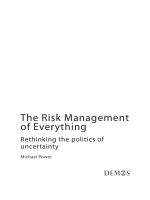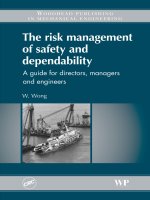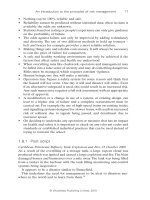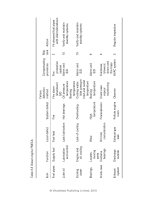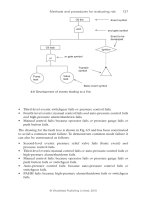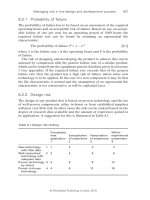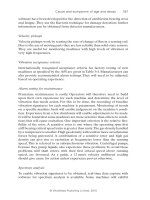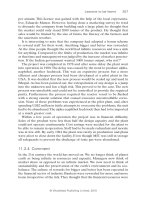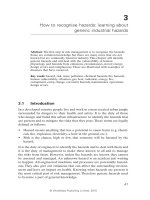Auditing the risk management process
Bạn đang xem bản rút gọn của tài liệu. Xem và tải ngay bản đầy đủ của tài liệu tại đây (1.63 MB, 287 trang )
AUDITING THE RISK
MANAGEMENT PROCESS
K.H. SPENCER PICKETT
John Wiley & Sons, Inc.
AUDITING THE RISK
MANAGEMENT PROCESS
AUDITING THE RISK
MANAGEMENT PROCESS
K.H. SPENCER PICKETT
John Wiley & Sons, Inc.
This publication includes extracts from AS/NZS 4360:2004 Risk management; HB 436-2004
Risk management guidelines and HB 158-2002 A guide to the use of AS/NZS 4360 Risk management within the internal audit process, all published by SAI Global Ltd, Sydney, Australia.
www.riskinbusiness.com. Reprinted with permission.
Extracts from Committee of Sponsoring Organizations, Enterprise Risk Management, Summary
and Framework, Spetember 2004, reprinted with permission from AICPA; Copyright © 2004 by
The Committee of Sponsoring Organizations of the Treadway Commission.
This book is printed on acid-free paper.
∞
Copyright © 2005 by John Wiley & Sons, Inc., Hoboken, New Jersey. All rights reserved.
Published simultaneously in Canada.
No part of this publication may be reproduced, stored in a retrieval system, or transmitted in any
form or by any means, electronic, mechanical, photocopying, recording, scanning, or otherwise,
except as permitted under Section 107 or 108 of the 1976 United States Copyright Act, without
either the prior written permission of the Publisher, or authorization through payment of the appropriate per-copy fee to the Copyright Clearance Center, Inc., 222 Rosewood Drive, Danvers, MA
01923, 978-750-8400, fax 978-646-8600, or on the web at www.copyright.com. Requests to the
Publisher for permission should be addressed to the Permissions Department, John Wiley & Sons,
Inc., 111 River Street, Hoboken, NJ 07030, 201-748-6011, fax 201-748-6008.
Limit of Liability/Disclaimer of Warranty: While the publisher and author have used their best
efforts in preparing this book, they make no representations or warranties with respect to the accuracy or completeness of the contents of this book and specifically disclaim any implied warranties
of merchantability or fitness for a particular purpose. No warranty may be created or extended by
sales representatives or written sales materials. The advice and strategies contained herein may not
be suitable for your situation. You should consult with a professional where appropriate. Neither
the publisher nor author shall be liable for any loss of profit or any other commercial damages,
including but not limited to special, incidental, consequential, or other damages.
For general information on our other products and services, or technical support, please contact our
Customer Care Department within the United States at 800-762-2974, outside the United States at
317-572-3993 or fax 317-572-4002.
Wiley also publishes its books in a variety of electronic formats. Some content that appears in print
may not be available in electronic books.
For more information about Wiley products, visit our Web site at www.wiley.com.
Library of Congress Cataloging-in-Publication Data:
Pickett, K.H. Spencer.
Auditing the risk management process / K.H. Spencer Pickett.
p. cm.
Includes index.
ISBN 0-471-69053-8 (cloth)
1. Auditing, Internal. 2. Risk management—Auditing. I. Title.
HF5668.25.P529 2005
658.15′11—dc22
2005000043
Printed in the United States of America
10 9 8 7 6 5 4 3 2 1
ABOUT THE INSTITUTE
OF INTERNAL AUDITORS
The Institute of Internal Auditors (IIA) is the primary international professional association, organized on a worldwide basis, dedicated to the promotion and development of the practice of internal auditing. The IIA is the recognized authority, chief
educator, and acknowledged leader in standards, education, certification, and research for the profession worldwide. The Institute provides professional and executive development training, educational products, research studies, and guidance to
more than 80,000 members in more than 100 countries. For additional information,
visit the Web site at www.theiia.org.
v
This book is dedicated
to the memory of Jenny Topham
CONTENTS
Preface
xiii
List of Abbreviations
Chapter 1
xv
Why Risk Management?
1
Introduction 1
Risk Management Framework Model: Phase One 5
Risk Management Framework Model: Phase Two 10
Risk Management Framework Model: Phase Three 14
Risk Management Framework Model: Phase Four 20
Risk Management Framework Model: Final 25
Summary 30
Notes 30
Chapter 2
Determining Risk Management Maturity
33
Introduction 33
Risk Management Maturity Model: Phase One 35
Risk Management Maturity Model: Phase Two 38
Risk Management Maturity Model: Phase Three 45
Risk Management Maturity Model: Phase Four 50
Risk Management Maturity Model: Final 57
Summary 64
Notes 65
Chapter 3
Enterprise-Wide Risk Management
Introduction 69
Enterprise Risk Management Model: Phase One 70
Enterprise Risk Management Model: Phase Two 73
Enterprise Risk Management Model: Phase Three 79
Enterprise Risk Management Model: Phase Four 80
Enterprise Risk Management Model: Final 88
ix
69
x
CONTENTS
Summary 95
Notes 95
Chapter 4
Risk Appetite
97
Introduction 97
Risk Appetite Model: Phase One 98
Risk Appetite Model: Phase Two 102
Risk Appetite Model: Phase Three 105
Risk Appetite Model: Phase Four 108
Risk Appetite Model: Final 110
Summary 114
Notes 115
Chapter 5
Control Risk Self-Assessment
117
Introduction 117
Control Risk Self-Assessment Model: Phase One 118
Control Risk Self-Assessment Model: Phase Two 122
Control Risk Self-Assessment Model: Phase Three 125
Control Risk Self-Assessment Model: Phase Four 129
Control Risk Self-Assessment Model: Final 136
Summary 139
Notes 140
Chapter 6
Developing an Audit Approach
141
Introduction 141
Audit Approach Model: Phase One 144
Audit Approach Model: Phase Two 150
Audit Approach Model: Phase Three 153
Audit Approach Model: Phase Four 162
Audit Approach Model: Final 165
Summary 172
Notes 173
Chapter 7
The Illusion of Perfection
Introduction 177
Poor Practice Model: Phase One 178
Poor Practice Model: Phase Two 184
177
CONTENTS
xi
Poor Practice Model: Phase Three 189
Poor Practice Model: Phase Four 193
Poor Practice Model: Final 196
Summary 200
Notes 200
Chapter 8
A Holistic ERM Concept
203
Introduction 203
ERM Program Model: Phase One 203
ERM Program Model: Phase Two 207
ERM Program Model: Phase Three 210
ERM Program Model: Phase Four 215
ERM Program Model: Final 219
Summary 223
Notes 223
Appendix A
Index
Applying an ERM Diagnostic Tool
225
265
PREFACE
Auditing New Horizons is a new series of short books aimed primarily at
internal auditors, but which will also be useful to external auditors, compliance teams, financial controllers, consultants, and others involved in reviewing governance, risk, and control systems. Likewise, the books should be
relevant to executives, managers, and staff as they are increasingly being
asked to review their systems of internal control and ensure that there is a
robust risk management process in place in all types of organizations. Each
book provides a short account of important issues and concepts relevant to
the audit and review community. The series will grow over the years and
Figure P.1 The Auditing New Horizon Book Series
1. Auditing the Risk
Management Process
FW
Framework—audit context
2. Risk-Based Audit
Planning
HT
FW
3. Effective Client
Relations
Framework—working with clients
How to fit audits into the organization
5. Managing the Audit
Team
HT
4. Setting Standards and
Quality
FW
Framework—audit professionalism
How to lead & develop auditors
7. Providing Meaningful
Assurances
FW
6. Getting to Grips with
Field Work HT
How to perform effective audits
Framework—for audit assurances
8. Audit Consulting
Projects
FW
Framework—consulting for clients
9. Control Risk SelfAssessment HT
How to develop CRSA programs
10. Dynamic Audit
Reporting
HT
How to ensure high impact reports
xiii
xiv
PREFACE
John Wiley & Sons, Inc., is working alongside the Institute of Internal
Auditors, Inc., to ensure that each new title reflects both current and
emerging developments. The framework for Auditing New Horizons is
illustrated in Figure P.1.
FrameWork (FW) books set out various models, supported by reference material that can be employed to ensure best practice pointers can be
assessed for their impact on current practice. HowTo (HT) books use similar models but focus more on checklists and worked examples that can
be employed to implementing aspects of relevant underlying frameworks.
Each book is immersed in the Institute of Internal Auditor’s Professional
Practices Framework in terms of their published standards, advisories,
and assorted guidance. Because the books are fairly succinct, reference to
other sources will need to be limited. There are no detailed case studies
taken from well-known companies in this book series because of the fastchanging pace of business, where current material quickly falls out of
date. The books do, however, refer to many short examples of what happens in different organizations as a way of illustrating important points.
The dynamic nature of the governance, risk, and control context means
that some new book titles for the Auditing New Horizons series may
change over the coming years. We hope that readers find the series both
interesting and stimulating and that this series will provide a reference
source that adds value to internal auditing, external auditing, and other
review functions.
LIST OF ABBREVIATIONS
BASEL: Committee on Banking Supervision
CAE: Chief Audit Executive
CEO: Chief Executive Officer
CFO: Chief Finance Officer
COSO: Committee of Sponsoring Organizations
CRO: Chief Risk Officer
CRSA: Control Risk Self-Assessment
CSA: Control Self-Assessment
ERM: Enterprise Risk Management
H&S: Health and Safety
IIA: Institute of Internal Auditors
IS: Information Systems
IT: Information Technology
KPI: Key Performance Indicators
OECD: Organization of Economic Cooperation and Development
PPF: Professional Practices Framework
PR: Public Relations
RA: Risk Assessment
RI: Risk Identification
RM: Risk Management
RO: Risk Owner
SEC: Securities and Exchange Commission
SIC: Statement on Internal Control
xv
1
WHY RISK MANAGEMENT?
The internal audit activity should assist the organization by identifying
and evaluating significant exposures to risk and contributing to the
improvement of risk management and control systems.
IIA Standard 2110
INTRODUCTION
Internal auditing has grown tremendously over the years to reflect its new
high-profile position in most larger organizations. It has shifted from
back-office checking teams to become an important corporate resource.
The focus on professionalism and objectivity has driven the new-look
auditor toward high-impact work that can really make a difference. The
key development that has underpinned this change relates to the shift
from enforcing controls on employees to using an assessment of risk to
empower management and their staff to establish meaningful controls
over their business. This move from must-do to want-to control cultures
has allowed employees more scope to innovate and experiment.
Unfortunately, in the past, robust risk management processes have not
always been in place. The rapid change programs of the 1980s and ’90s
meant that many organizations were likened to speeding trains that would
leave behind anyone who was not bold enough to jump on board and hang
on for dear life. Investors expected quick returns, while competition was
about being the first to bring new or improved products to the marketplace—or at least give that impression. The resultant crashes and scandals
that rebounded throughout the last decade underpinned the lack of clear
direction or ethical values that could be described as the much-needed rail
signals and brakes—to continue our train analogy.
Reckless trading against the backdrop of the cutthroat competition of
the 1990s continued into 2000 and beyond, before the regulators started to
get tough. The old governance models of a select board of high achievers
1
2
Auditing the Risk Management Process
gathered around a powerful CEO, whose only accountability was to publish financial accounts that had been reviewed by a friendly auditor, could
not cope with the new business dynamic. In this type of environment, regulations were seen as obstacles to be sidestepped. Corporate lawyers were
often used to design roadmaps to allow the executive teams to weave a
path through legal provisions and industry-specific regulations. Societal
concerns came to a head in 2002, with the publication of the SarbanesOxley Act, to enshrine personal responsibility at the top of each company
to adhere to the rules and demonstrate that this is the case. The link
between risk management and corporate governance has been explored by
the Institute of Internal Auditors (IIA):
Risk management is a fundamental element of corporate governance.
Management is responsible for establishing and operating the risk management framework on behalf of the board.1
In the past, control frameworks have helped in setting standards, but
they often acted as basic benchmarks to be checked off against and often
ended up as just checks in the Compliance Box, something that is done
and then filed away—until the same time next year. Nowadays, the new
focus is firmly on risk—to the business, executives, and stakeholders.
Several societal concerns appear at the forefront of this idea of risk,
including the risks that:
•
•
•
•
•
•
•
•
•
Published accounts are misleading.
Performance information is fudged.
Regulatory disclosures are not supported by sound evidence.
Senior executives are making uninformed assertions about the adequacy of controls over financial reporting and compliance procedures.
The corporate asset base is not properly protected from waste, loss,
attack, or natural disaster.
The corporate reputation militates against customer loyalty.
Operations and processes are inefficient and inflexible.
The wrong people are being promoted and recruited.
The organization is failing to meet the changing expectations of
customers, the marketplace, and stakeholders generally.
Attempts to address these issues have led organizations in the direction of Enterprise Risk Management (ERM). That is a wholesale approach
to identifying and managing risk across all aspects of the business—from
a strategic standpoint. As each risk changes in impact and urgency, so
Why Risk Management?
3
does the organization respond to ensure that any damage is limited and
opportunities are exploited through using gaps in the market thrown up by
new risks. In fact, the main feature of a successful enterprise is its ability
to anticipate and deal with global risks more efficiently than other similar
organizations. In this scenario where the stakes are so high, the role that
is carved out by the internal auditor becomes all the more important.
If ERM is to be a key driver for success, the various parties that affect the
ERM framework that is built to address risk across the business become a
fundamental concern. Where each party has a clear role, there is a need to
discharge the precise responsibilities of each of these roles. Any shortfalls
may lead to problems. The choices made by the Chief Audit Executive, in
the context of the audit approach to ERM, are likewise important, and
nothing should be left to chance.
If organizations faced no risk, there would be no need to employ internal audit staff. The organization would always be in complete control, and
there would be no need to review, adjust, realign, or even implement internal controls. The auditor exists because plans do not always go as intended,
and things don’t always appear as they really are. The auditor is needed
to ensure that the organization understands its risks and has taken steps to
both handle foreseeable problems and seize potential advantages. Advising, helping, cajoling, and issuing warnings are all tools that may be
employed by the auditor to put risk on the agenda and ensure that it is given
proper consideration. This combination of effort to achieve a risk-smart
workforce means that the auditor is fast becoming what some now refer to
as a critical friend to executives, management, and employees generally.
Before we launch our first model, we need to outline the formal definition of internal auditing from the IIA:
Internal auditing is an independent, objective assurance and consulting
activity designed to add value and improve an organization’s operations.
It helps an organization accomplish its objectives by bringing a systematic, disciplined approach to evaluate and improve the effectiveness of
risk management, control, and governance processes.2
As is clear from this definition, internal auditing is firmly rooted in
the risk management, control, and governance agenda. Dave Richards,
President of the IIA, presented at the IIA’s Enterprise Risk Management
and Control Self-Assessment* Conference in Las Vegas, Nevada, on
September 9, 2004, which is reported as follows:
*Control Risk Self-Assessment (CRSA) is also called Control Self-Assessment (CSA); the
two terms are interchangeable.
4
Auditing the Risk Management Process
Richards highlighted key ERM and CSA trends, including legislative
movements around the world emphasizing the need for risk management
as well as signs that internal auditors are becoming more proactive in
the use of risk-assessment processes. Although CSA has not been fully
embedded in many organizations, he said ERM is becoming known as
a key ingredient to good governance, and internal auditors should promote its adoption and progression. In Richards’ closing comments he
encouraged the audience by saying, “It couldn’t be a better time to be in
the internal audit profession,” and challenged participants to advocate
risk management processes within their organizations while keeping
internal audit standards and basic principles at the forefront of their
audit activities.3
This sets the challenge: To help and support management as they
struggle with establishing good risk management in the organization,
while ensuring that the rigorous provisions of audit standards are retained.
Risk management is defined by the IIA as:
A process to identify, assess, manage, and control potential events or situations, to provide reasonable assurance regarding the achievement of
the organization’s objectives.4
Enterprises include all public and private-sector organizations, and
enterprise risk management is described as:
A structured, consistent and continuous process across the whole organization for identifying, assessing, deciding on responses to and reporting
on opportunities and threats that affect the achievement of its objectives.5
We will also be devoting some time to a landmark document on ERM,
which was launched by the Committee of Sponsoring Organizations
(COSO) on September 29, 2004. COSO consists of five major professional
associations in the United States and was formed in 1985 to sponsor the
National Commission on Fraudulent Financial Reporting. All further references in this book to COSO ERM relate to the 2004 COSO ERM framework. Further information on COSO and their publications can be viewed
on their Web site at www.coso.org. COSO provides the following commentary in its foreword to ERM guidance:
The need for an enterprise risk management framework, providing key
principles and concepts, a common language, and clear direction and
guidance, became even more compelling. COSO believes this Enterprise
Risk Management—Integrated Framework fills this need, and expects it
Why Risk Management?
5
will become widely accepted by companies and other organizations and
indeed all stakeholders and interested parties.6
RISK MANAGEMENT FRAMEWORK MODEL: PHASE ONE
Our first model looks at the way risk management resides in an organization. We start at the top of an enterprise with the position of the CEO and
the board and the way they respond to the pressure to ensure good corporate governance in Figure 1.1.
Figure 1.1 Risk Management Framework Model: Phase One
Mission
THE CEO
& BOARD
External Global
and Market
Developments
STRATEGY FORMATION
Statutes,
Regulators’
Codes and
Guidance
SENIOR
MANAGEMENT
STRATEGY IMPLEMENTATION
Each aspect of the model is described below.
External Global and Market Developments
Risk is inherent in the way global events shift in the economy, including
changing interest rates, international developments, and the fluctuating
movement of capital. Meanwhile, markets are constantly changing as
consumer demand alters and competitors enter or leave the marketplace.
Public-sector services are also affected by constant changes in the demands
6
Auditing the Risk Management Process
and expectations of society. This sense of uncertainty has been summed
up by COSO:
Enterprises operate in environments where factors such as globalization,
technology, restructurings, changing markets, competition and regulation create uncertainty.7
Statutes, Regulations, Codes, and Guidance
Governance codes and company legislation can be generic or industry
specific, and they create additional demands on enterprises—normally in
response to heightened expectations from society, or as a result of corporate scandals that revealed a need to tighten up on existing regulations.
The most famous of the more recent laws arrived several years ago in the
guise of Sarbanes-Oxley, with the resulting impact on companies listed on
the New York Stock Exchange and NASDAQ. An assortment of local
state laws also add to the compliance framework within which enterprises
must operate. Some professions, such as law, medical practice, and
accounting, provide various codes of conduct and specific regulations that
must be adhered to by their practicing members. Within this context, governance is about the way organizations conduct themselves and administer their affairs. The IIA’s definition of governance is:
The combination of processes and structures implemented by the board
in order to inform, direct, manage and monitor the activities of the
organization toward the achievement of its objectives.8
Most significant organizations understand the need to respond properly to the wider demands of society as expressed through the regulators.
The foreword to the COSO ERM addresses this important point:
The period of the framework’s development was marked by a series of
high-profile business scandals and failures where investors, company
personnel, and other stakeholders suffered tremendous loss. In the aftermath were calls for enhanced corporate governance and risk management, with new law, regulation, and listing standards.9
Business performance goes hand in hand with regulatory performance, as described by one large retail company:
Our size and global reach present extraordinary opportunities, but also
present additional complexity in dealing with an ever-changing variety
Why Risk Management?
7
of laws and regulations. Keeping pace with changes in the regulatory
environment is a challenge for management, but we are committed to do
so. We continually monitor our legal and regulatory performance, and
will upgrade internal systems or change the way we do business when
necessary in order to assure compliance.10
The Mission
The risk management framework is driven by what the organization is
trying to achieve, which, at its highest level, is the overall mission. For
example, the mission of the Ford Motor Company is stated as:
We are a global family with a proud heritage passionately committed to
providing personal mobility for people around the world. We anticipate
consumer need and deliver outstanding products and services that improve people’s lives.11
Meanwhile, the company’s future vision is:
To become the world’s leading consumer company for automotive products and services.12
Many corporate governance codes argue that corporate objectives
should be enriched by ensuring that they also address wider societal
concerns:
In addition to their commercial objectives, companies are encouraged to
disclose policies relating to business ethics, the environment and other
public policy commitments.13
The reality of private, public-sector, and not-for-profit environments
means that there can never be total certainty that the mission will always
be fully achieved and make the vision a reality. Risk is about this lack of
certainty, and it has been defined as follows:
Risk is the chance of something happening that will have an impact on
objectives. Therefore, to ensure that all significant risks are captured, it
is necessary to know the objectives of the organization function or activity that is being examined....Organizational success criteria are the
basis for measuring the achievement of objectives, and so are used to
identify and measure the impacts or consequences of risks that might
jeopardize those objectives.14
